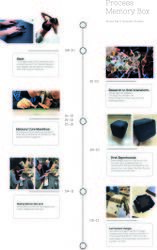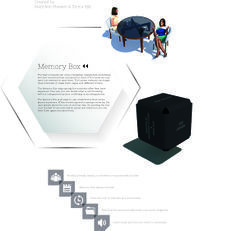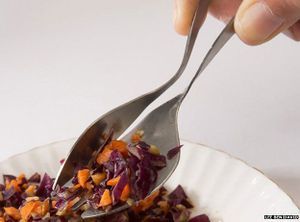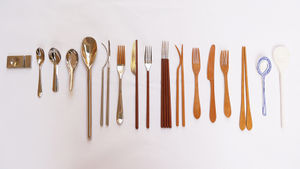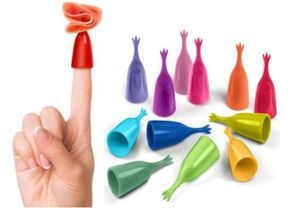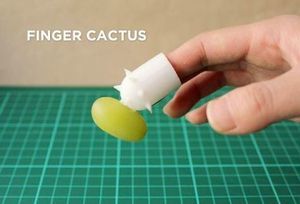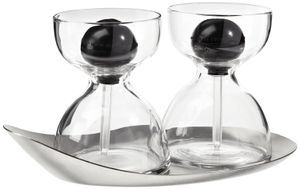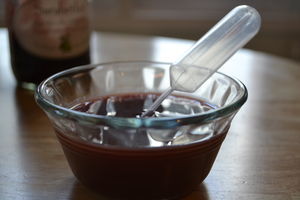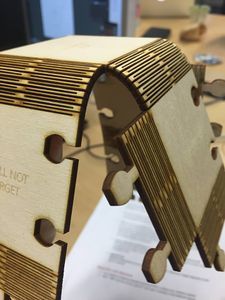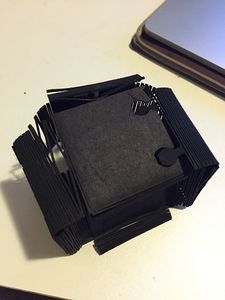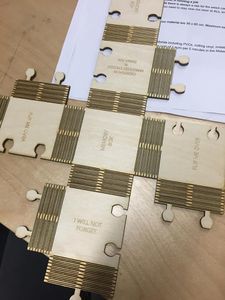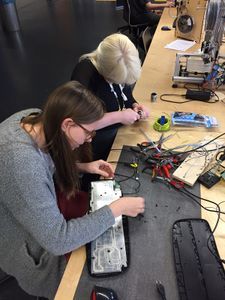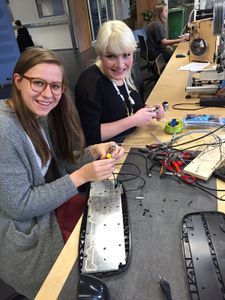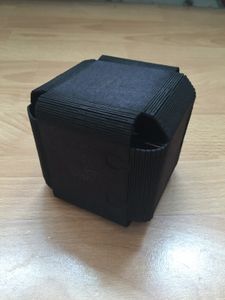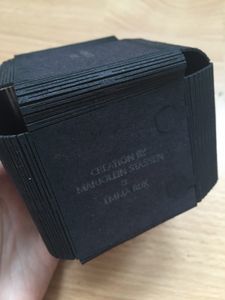Difference between revisions of "MB"
(Created page with "=Project Jon, Memory Haptic= 08-10 Start of assignment. Combining muscle memory and haptics. Experiencing seasons throughout A year can be different for anyone. What makes...") |
|||
| Line 1: | Line 1: | ||
| + | ==Results Quarter 9== | ||
| + | |||
| + | <gallery mode="nolines" widths="250px" heights="250px"> | ||
| + | poster5.jpg| | ||
| + | poster4.jpg| | ||
| + | </gallery> | ||
| + | |||
| + | |||
=Project Jon, Memory Haptic= | =Project Jon, Memory Haptic= | ||
Revision as of 14:13, 20 January 2016
Contents
Results Quarter 9
Project Jon, Memory Haptic
08-10 Start of assignment.
Combining muscle memory and haptics.
Experiencing seasons throughout A year can be different for anyone. What makes the same time and circumstances feel different for everyone.
MUSCLE MEMORY // RESPONSIVENESS (LIFE THREATENING SITUATIONS)
How to fall Diving Playing Instrument Biking Horse Riding Writing Nascar Drivers
Ideas
Going against Reflexes.
Tricking into mobile use
Everything the other way around.
Fighting habits
Changing eating habits. In the future not only we will have one universal language but also one universal eating habits with a new set of cutlery.
An interesting link to a few projects of PHILIPS evolving around food and future machines. [1]
MUSCLE MEMORY // RESPONSIVENESS (LIFE THREATENING SITUATIONS)
- How to fall
- Diving
- Playing Instrument
- Biking
- Horse Riding
- Writing
- Nascar Drivers
https://www.youtube.com/watch?v=zgU0QeBYH68 - One Breath Diving
- Ignoring Voice Warning in Brain
- Shutting
HAPTIC
Haptics is Quite Literally The Science of Touch. The origin of the word haptics is the Greek haptikos, meaning able to grasp or perceive. Haptic sensations are created in consumer devices by actuators, or motors, which create a vibration.
Haptic or kinesthetic communication recreates the sense of touch by applying forces, vibrations, or motions to the user. This mechanical stimulation can be used to assist in the creation of virtual objects in a computer simulation, to control such virtual objects, and to enhance the remote control of machines and devices (telerobotics). Haptic devices may incorporate tactile sensors that measure forces exerted by the user on the interface.
Haptic communication refers to the ways in which people and other animals communicate and interact via the sense of touch. As well as providing information about surfaces and textures, touch, or the haptic sense, is a component of communication in interpersonal relationships that is nonverbal and nonvisual. Touch is extremely important for humans and is vital in conveying physical intimacy.
Touch can be categorized in terms of meaning as positive, playful, control, ritualistic, task-related or unintentional. It can be both sexual (kissing is one such example that is sometimes sexual) and platonic (such as hugging or tickling). Touch is the earliest sense to develop in the fetus. The development of an infant's haptic senses and how it relates to the development of the other senses such as vision has been the target of much research. Human babies have been observed to have enormous difficulty surviving if they do not possess a sense of touch, even if they retain sight and hearing. Babies who can perceive through touch, even without sight and hearing, tend to fare much better.
In chimpanzees the sense of touch is highly developed. As newborns they see and hear poorly but cling strongly to their mothers. Harry Harlow conducted a controversial study involving rhesus monkeys and observed that monkeys reared with a "terry cloth mother", a wire feeding apparatus wrapped in softer terry cloth which provided a level of tactile stimulation and comfort, were considerably more emotionally stable as adults than those with a mere wire mother.[1] Touching is treated differently from one country to another. Socially acceptable levels of touching varies from one culture to another. In the Thai culture, touching someone's head may be considered to be rude. Remland and Jones (1995) studied groups of people communicating and found that in England (8%), France (5%) and the Netherlands (4%), touching was rare compared to the Italian (14%) and Greek (12.5%) sample.[2]
Striking, pushing, pulling, pinching, kicking, strangling and hand-to-hand fighting are forms of touch in the context of physical abuse. In a sentence like "I never touched him/her" or "Don't you dare to touch him/her" the term touch may be meant as euphemism for either physical abuse or sexual touching. To 'touch oneself' is a euphemism for masturbation. The word touch has many other metaphorical uses. One can be emotionally touched, referring to an action or object that evokes an emotional response. To say "I was touched by your letter" implies the reader felt a strong emotion when reading it. It usually does not include anger, disgust or other forms of emotional rejection unless used in a sarcastic manner. Stoeltje (2003) wrote about how Americans are ‘losing touch’ with this important communication skill. During a study conducted by University of Miami School of Medicine, Touch Research Institutes, American children were said to be more aggressive than their French counterparts while playing at a playground. It was noted that French women touched their children more often than the American parents.
Haptic perception (Greek: haptόs „palpable“, haptikόs „suitable for touch“) literally denominates "to grasp something". Perception in this case is achieved through active exploration of surfaces and objects by a moving subject as opposed to passive contact of a static subject during tactile perception.[1] The term Haptik was coined by the German Psychologist Max Dessoir who suggested in 1892 to name the academic research about the sense of touch in the style of „acoustics“ and „optics“.[2][3]
Gibson (1966)[4] defined the haptic system as "The sensibility of the individual to the world adjacent to his body by use of his body". Gibson and others further emphasized what Weber had realized in 1851 - the close link between haptic perception and body movement: haptic perception is active exploration.
The concept of haptic perception is related to the concept of extended physiological proprioception according to which, when using a tool such as a stick, perceptual experience is transparently transferred to the end of the tool.
Haptic perception relies on the forces experienced during touch.[5] This research allows the creation of "virtual", illusory haptic shapes with different perceived qualities[6] which has clear application in haptic technology.[7]
DIFFICULT SPORTS
Cross-Country Running: Cross Country Running is a type of sport where individuals or teams run a race on open-air courses generally 4 – 12 kilometers long over natural terrain. The event is typically organized during autumn and winter but in some scenarios it may be organized in a wide range of temperatures to create maximum difficulty. Cross Country Running was started in the 19th century in England where the schools started participating in cross country races as early as in 1837. The first recorded national cross country championship was held on Wimbledon Common in south-west London on 7th December, 1867. The first international cross country race was organized on 28th March, 1903, at the Hamilton Park Racecourse in Scotland. The IAAF World Cross Country Championships is the elite competition of the modern days cross country race since it was established in 1973.
Freestyle Wrestling: Freestyle wrestling is a form of amateur wrestling that is practiced by many wrestling fanatics all over the world. It is one of two styles of wrestling besides the Greco-Roman Wrestling that is contested in the Olympic Games. The ultimate goal of these sports is to pin down the opponent to the mat which results in the victory. Freestyle wrestling is one of the four main styles of global wrestling according to the international governing body for the sport, United World Wrestling. The modern variant of freestyle wrestling is believed to be originated as the “catch-as-catch-can” wrestling in the United States and Great Britain. Interestingly, “catch-as-catch-can” wrestling was performed by several U.S. presidents such as Abraham Lincoln, George Washington, Theodore Roosevelt and many more.
Horseback Riding: Horseback Riding or the Equestrianism involves steeple chasing or vaulting with horses and riding horses. The horses are trained to perform a set of skills on the course or to achieve great speed and the co-ordination between the horse and the jockey or the horse rider has a great impact on the event. Many historian claims that trained horses were first ridden in approximately 4500 BC, where numerous other historians doubted that horses were ridden long before this claim. Thoroughbred horse racing or flat racing is the most popular form of these sports and is governed by the Royal Charter Jockey Club in the UK and the Jockey Club in the USA. Steeplechasing or National Hunt racing is also a popular variant of the sport where the horses jump over obstacles while racing on a track. The international governing body of Horseback Riding is the International Federation for Equestrian Sports.
Bull Riding': Bull Riding is the most popular type of Rodeo sports where the rider attempts to stay mounted while the bull attempts to buck off the rider. The rider must stay for eight seconds atop the bucking bull and due to the risk it is often referred as “the most dangerous eight seconds in sports.” Bull riding was derived from the Mexican Charreada. One of the earliest variant of Bull Riding called Jaripeo, a hacienda contest, was developed during the 16th century where the riders rode the bull until it stopped bucking or till the rider dies. A Texas Ranger named H. L. Kinney staged the first Anglo-American organized bullfight in 1852 in the southwest. Both the rider and the bull are awarded from 0–50 points by two judges based on several fundamental aspects of the event. Cowboy boots and hats are the additional attractions of these sports besides the riding.
Water Polo: Water polo is a team water sport consisting of four periods where two teams attempt to score goals by throwing the ball into the opponent’s net. Each team of this game consists of six field players and one goalkeeper in the water. Water Polo typically played in at least 1.8meters deep pools with a water polo ball that floats on the water. The game comprises swimming, catching and shooting the ball using a single hand. The game is considered to be originated as a sort of “water rugby” in the late 19th century in Scotland. William Wilson first organized a set of rules for a team water ball game called “aquatic football” in 1877. The first ever game of Aquatic Football or Water Polo was organized at the Bon Accord Festival between the banks of the River Dee in Aberdeen, Scotland in the late 19th century. Fédération Internationale de Natation is the governing body of this game on international level.
Figure Skating: Figure Skating is a type of sport where teams, duos or individual skaters perform on figure skates on ice. Men’s singles, ladies’ singles, ice dancing and pair skating are the four main Olympic disciplines of this game. Figure Skating was first introduced in the 1908 Summer Olympics in London as the first winter sports in Olympic. The International Skating Union is the governing body of international Figure Skating that includes the Winter Olympics, the World Championships, the Four Continents Championships, the European Championships and the Grand Prix of skating. Figure skating blades used in this sport is typically 4.7mm thick with a slight curve of an arc of a circle having a radius of 180-220cm. Figure skaters usually perform spins, lifts, jumps, throw jumps, moves in the field, death spirals and various other moves.
Motor Cross: Motorcross is a form of off-road motorcycle racing on enclosed off-road circuits. It is one of the most physically demanding sports and usually organized in all-weather conditions. Motocross is believed to be originated from motorcycle trials competitions in the United Kingdom. The earliest reference of the origination this sport can be found in the first quarterly trial of the Auto-Cycle Clubs in 1906 and the Scottish Six Days Trial in 1909. The word “Motocross” is a combination of Motocyclette, the French word for motorcycle, with “cross country”. The first ever scramble race or modern Motocross was held in 1924 at Camberley, Surrey. The FIM Motocross World Championship, the AMA Motocross Championship, British Motocross Championship and Motocross des Nations are the major event of the Motocross. This sport is internationally governed by the Fédération Internationale de Motocyclisme.
Skiing: Skiing is a form of ice sports where contestants use skis to glide on snow. The word “Ski” derived from “skíð”, an Old Norse word that means “split piece of wood or firewood”. This sport is internationally governed by the International Olympic Committee and the International Ski Federation. The earliest reference of Skiing was found in a primitive carving located in Rødøy in the Nordland region of Norway depicting a skier with one pole from circa 5000 B.C. Skiing was first primarily used for transport and Military ski races were held during the 18th century in Norway. Two main genres of this sport, the Alpine Skiing and the Nordic Skiing were developed in the 1930s. Slalom, Giant Slalom, Super-G, Alpine skiing combined and Downhill are the main discipline of Alpine skiing. Cross-country, Telemark, Ski touring, Skijoring and Ski-flying are the main discipline of Nordic skiing.
Swimming: Swimming is a type of water sport where swimmers try to swim as fast as possible with various strokes such as Butterfly stroke, Backstroke, Breaststroke and Freestyle. It is internationally governed by the Fédération Internationale de Natation. The earliest reference of swimming was found in paintings dates back to the Stone Age around 8000 B.C. The reference of swimming can also be traced in ancient books such as the Bible, the Quran, the Gilgamesh, the Iliad, the Odyssey and the Beowulf. The first swimming book called “Der Schwimmeroder ein Zweigesprächüber die Schwimmkunst” was written by a German professor of languages Nikolaus Wynmann in 1538. The first indoor swimming pool named St George’s Baths was opened in 1828 for the public. The National Swimming Society held swimming competitions in six artificial swimming pools in London in 1837.
Gymnastics: Gymnastics is a complex sport that needs physical strength, flexibility, grace, agility, power, coordination, balance and control. The Fédération Internationale de Gymnastique founded in 1881 governs the competitive gymnastic events internationally, with each country having its own national governing body. Modern gymnastics was first developed by three pioneer physical educators in the late eighteenth and early nineteenth century Germany, in the form of exercises for young men and boys, on apparatus. Of the gymnastic events, the competitive gymnastics is considered the best known. The men’s events include high bar, parallel bars, vault, still rings, pommel horse and floor exercise, while the women’s events include vault, floor exercise, balance beam, uneven bars. Exercises used by the ancient Greeks have been evolved in gymnastics. There are several other gymnastic disciplines.
OUR BODY
How Much Pain Can The Human Body Endure? Pain is both a universal truth and universal dread. It has driven some men to isolation, others to suicide. And though it may take various forms — emotional, psychological, even moral — most would agree physical pain is the kind we feel the greatest desire to immediately end. “We don’t even ask happiness, just a little less pain,” said poet Charles Bukowski. So what are the most physically painful experiences? We, being Medical Daily, will focus on health conditions though we add a grace note of other sorts of suffering. In no particular order, we believe the following conditions provide the most excruciating of physical agonies.
Cluster headaches, which affect less than one percent of people, are marked by unbearable stabbing and penetrating pain, usually centered around the eye. These severe headaches occur suddenly and peak within 15 minutes. They run in families, with mostly men suffering from this particular pain.
Childbirth is so piercing a pain, mothers' make a point of telling their children they 'forget' how bad it is… need we say more?
Shingles is a painful skin rash, the remnants of your childhood case of chickenpox. Generally it occurs among older adults, sometimes pregnant women, and usually affects just one side of the body, often the face or torso. Even wearing light clothes adds to the suffering.
Kidney stones are hard deposits that form inside your kidneys and then travels through your urinary tract. You ‘pass’ a kidney stone while urinating and generally the stones cause no permanent damage. However, those who've actually passed a kidney stone say you feel that hard little rock every millimeter of its journey through you.
Gallstones are another type of hard deposit, sometimes the size of a golf ball, that form inside your gallbladder — a small, pear-shaped organ just beneath your liver. On the same order as kidney stones, except these require surgery to be removed.
Tooth abscess, which causes a gnawing and shooting pain, is actually just a collection of infected pus, arising from a bacterial infection, in the center of your tooth. This worst of all dental pains requires, in many cases, root canal or wholesale removal of your tooth.
Trigeminal neuralgia, though rare, is a chronic condition affecting a nerve that runs along your face to your brain. The stabbing pain, which has been described as feeling an electric shock, becomes progressively worse over time for most sufferers.
Severe burns are painful, not only when they happen, but as they are healing. The most serious, a third degree burn, involves all layers of your skin along with fat, muscle, and in some cases bone affected as well. A second degree burn, though considered less severe, may be equally agonizing.
Fibromyalgia, which affects more women than men, is a widespread ache in the muscles that is accompanied by headaches and fatigue. It is debilitating in that it is chronic; a quarter of all people with this condition are unable to work.
A spinal tap, which involves the insertion of a needle between two vertebrae in order to remove a sample of cerebrospinal fluid, is notoriously one of the worst procedures you can endure at the hands of a doctor.
Torture is, by definition, pain: it is the act of causing pain as a form of punishment or as a way to force another person to do your will. The Latin base for this word means ‘to twist.’ Any form of torture, and please, please, please let's not go there, simply hurts. Bad.
Finally, we end with initiation rites, which may include anything from teeth chiseling to circumcision. The coming-of-age ritual experienced by Hamish Blake, one half of an Australian comedy duo, involved placing his hands inside gloves filled with biting bullet ants.
IDEAS
- Going against Reflexes.
- Tricking into mobile use
- Everything the other way around.
- Fighting habits
- Changing eating habits.
In the future not only we will have one universal language but also one universal eating habits with a new set of cutlery.
Progress 04-10 Future Food
What happens when people eat and everything except for the food is registered? Wich things make our sitting together and having food an exceptional experience?
In this week we decided to take a more poetic approach to the future food concept. We mainly want to focus on the stories told while eating.
During our conversations we decided to focus on the stories being told while having dinner together. Just like the program 'Man Bijt Hond' we will go to people and join them while having food together. The stories that are being told while function as a tool to create our memory machine.
We also found inspiration in the hitsong of Adele; Turning tables [2]
Adele found her inspiration for this song while having dinner with her friends in a restaurant that has turning tables.
Research about sound pitches: [3] [4]
FUTURE FOOD
Insects, fake meat, seaweed and 3D-printed food all have the potential to address malnutrition.
- No cutlery needed, only powers and drinks.
- Mini-livestock (Insects)
- Lab-grown Meat
- Algae
- Seaweed
Earlier this year, Dutch scientists successfully produced in-vitro meat, also known as cultured meat. They grew strips of muscle tissue using stem cells taken from cows, which were said to resemble calamari in appearance. They hope to create the world's first "test-tube burger" by the end of the year.
- http://www.theguardian.com/global-development-professionals-network/2014/aug/12/insects-algae-lab-meat-food
- http://www.bbc.com/news/magazine-18813075
- https://www.youtube.com/watch?v=lCNSst-_z5c
- https://youtu.be/hZ8an4GHEfo
Underused and Overlooked
About 2,500 plant species have been domesticated for food. But today, almost half our food calories come from just three grains: wheat, maize, and rice. What about the thousands of overlooked plant species—and an untapped diversity of animals? These resources could provide solutions to problems like the need for resilience in our food production systems and the need to meet growing demands without depleting natural resources. Here are a few promising examples:
Algae: Seaweed and other algae, already popular in Japan, are highly nutritious and can be grown in both fresh water and salt water. Insects: Over 2,000 species of insects are already eaten worldwide, including mopane worms (Gonimbrasia belina) in South Africa. Insects are high in protein and require much less land, water, and food than animals raised for meat Quinoa: This grain (Chenopodium quinoa) from the Andes contains all the essential amino acids the human body needs for protein and has no gluten. Emmer wheat: While millions are spent on high-tech hybrids, neglected crops like the grain emmer (Triticum dicoccum), which requires less fertilizer and fewer pesticides than currently used breeds, are already being grown in places like Turkey. Minor millets: These cereals have been grown in Asia for 6,500 years. Many farmers in India and Nepal are now switching from growing crops like maize and rice back to traditional varieties bred to grow on local mountainsides. Peach palm: The peach palm (Bactris gasipaes) grows well in Central and South America and produces a large, nutritious fruit. The tree’s spiny trunk makes the fruit hard to harvest—but breeders are now developing spineless varieties. Giant swamp taro: The giant swamp taro (Cyrtosperma chamissonis), which grows well in the salty, sandy soil of many Pacific islands, is rich in vitamins and minerals. Yellow varieties are high in beta carotene, which can help prevent blindness. Sea buckthorn: Sea buckthorn (Hippophae rhamnoides) uses nitrogen from the air as fertilizer, thanks to specialized bacteria in its roots. These dense roots are also used to prevent soil erosion in China. The berries are hard to pick, but new machines should help with the harvest. Foods of Tomorrow?
Many foods we’ll eat in the future don’t yet exist. Researchers constantly tinker with plant and animal ingredients, processed foods and even packaging, to improve flavor and nutrition. A few samples are below—but the biggest changes may come from ideas we cannot yet imagine.
Breathable Chocolate: Want the flavor of real chocolate, without the calories? You can now inhale tiny particles of chocolate, as a mist. Patch in a Pinch: Some essential nutrients could soon be given to soldiers and astronauts through a patch on the skin, for quick absorption in emergencies. "Smart Packaging": In the near future, food packaging could monitor foods to detect ripeness or spoiling—or even actively prevent foods from spoiling.
GOING FROM INDUSTRIAL MODEL TO ECOLOGICAL MODEL
CUTLERY / TABLEWEAR
Cutlery refers to any hand implement used in preparing, serving, and especially eating food in the Western world. A "cutler" is a person who makes or sells cutlery. The city of Sheffield in England has been famous for the production of cutlery since the 17th century and a train - the Master Cutler - running from Sheffield to London was named after the industry.
Cutlery is more usually known as silverware or flatware in the United States, where cutlery usually means knives and related cutting instruments. Although the term silverware is used irrespective of the material composition of the utensils, the term tableware has come into use to avoid the implication that they are made of silver.
The major items of cutlery in the Western world are the knife, fork and spoon. In recent times, hybrid versions of cutlery have been made combining the functionality of different eating implements, including the spork (spoon / fork), spife (spoon / knife), and knork (knife / fork) or the sporf which is all three.
Tableware is the dishes or dishware used for setting a table, serving food and dining. It includes cutlery, glassware, serving dishes and other useful items for practical as well as decorative purposes. The quality, nature, variety and number of objects varies according to culture, religion, number of diners, cuisine and occasion. For example, Middle Eastern, Indian or Polynesian food culture and cuisine sometimes limits tableware to serving dishes, using bread or leaves as individual plates. Special occasions are usually reflected in higher quality tableware.
"Dinnerware" is another term used to refer to tableware and "crockery" refers to ceramic dishes in everyday use as differentiated them from the fine porcelain and bone china produced by makers such as Sèvres in France, Meissen in Germany, Royal Copenhagen in Denmark, Royal Doulton in England, or Belleek Pottery in Ireland.[4] Sets of dishes are referred to as a table service, dinner service or service set. Table settings or place settings are the dishes, cutlery and glassware used for formal and informal dining. In Ireland such items are normally referred to as delph, the word being an English language phonetic spelling of the word delft, the town from which so much delftware came. Silver service or butler service are methods for a butler or waiter to serve a meal.
Setting the table refers to arranging the tableware, including individual place settings for each diner at the table as well as decorating the table itself in a manner suitable for the occasion. Tableware and table decoration is typically more elaborate for special occasions. Unusual dining locations demand tableware be adapted.
https://en.wikipedia.org/wiki/Tableware
History
The first documented use of the term "cutler" in Sheffield appeared in a 1297 tax return. A Sheffield knife was listed in the King's possession in the Tower of London fifty years later. Several knives dating from the 14th century are on display at the Cutlers' Hall in Sheffield.[2]
Cutlery has been made in many places. In Britain, the industry became concentrated by the late 16th century in and around Birmingham and Sheffield. However, the Birmingham industry increasingly concentrated on swords, made by "long cutlers", and on other edged tools, whereas the Sheffield industry concentrated on knives.
At Sheffield the trade of cutler became divided, with allied trades such as razormaker, awlbladesmith, shearsmith and forkmaker emerging and becoming distinct trades by the 18th century.
Before the mid 19th century when cheap mild steel became available due to new methods of steelmaking, knives (and other edged tools) were made by welding a strip of steel on to the piece of iron that was to be formed into a knife, or sandwiching a strip of steel between two pieces of iron. This was done because steel was then a much more expensive commodity than iron. Modern blades are sometimes laminated, but for a different reason. Since the hardest steel is brittle, a layer of hard steel may be laid between two layers of a milder, less brittle steel, for a blade that keeps a sharp edge well, and is less likely to break in service.
After fabrication, the knife had to be sharpened, originally on a grindstone, but from the late medieval period in a blade mill or (as they were known in the Sheffield region) a cutlers wheel.
TABLEWEAR AS MEMORY MAKING TOOLS
Each thing on the table will record a certain pitch (connected to an emotion). The whole set on the table will record the conversation but to play the memory you will need all the table wear to re-play the conversation.
Under Tableware we see:
- Plate
- Knife
- Fork
- Spoon
- Tablemat
- Drinking Glass / Karaf
- Food Dish
What you need:
- Table
- 4 Chairs
Object Use:
- Plate = Middle
- Knife = High Pitch (sharp)
- Fork = Middle//high
- Spoon = Low/Middle
- Tablemat = Low Pitch (bottom)
- Drinking Glass / Karaf = Ultra High
- Food Dish = background noises. Other.
- Table = Speaker
- 4 Chairs + Complete tableware set = record
INSTANT MOMENT RECORDER
As part of a dining experience we will design a cube that is always listening to your conversations. Once something memorable happens you can push over the cube and then it will play the last 15 secs. If you want to save it you can do so with a single tap.
Possible parts for the recording cube:
- wireless tranceiver for arduino with 2,4ghz reach
- DS3231 High Precision Real-Time Clock Module - Blauw (3.3 ~ 5.5V)
- touch knop
- sound filter
